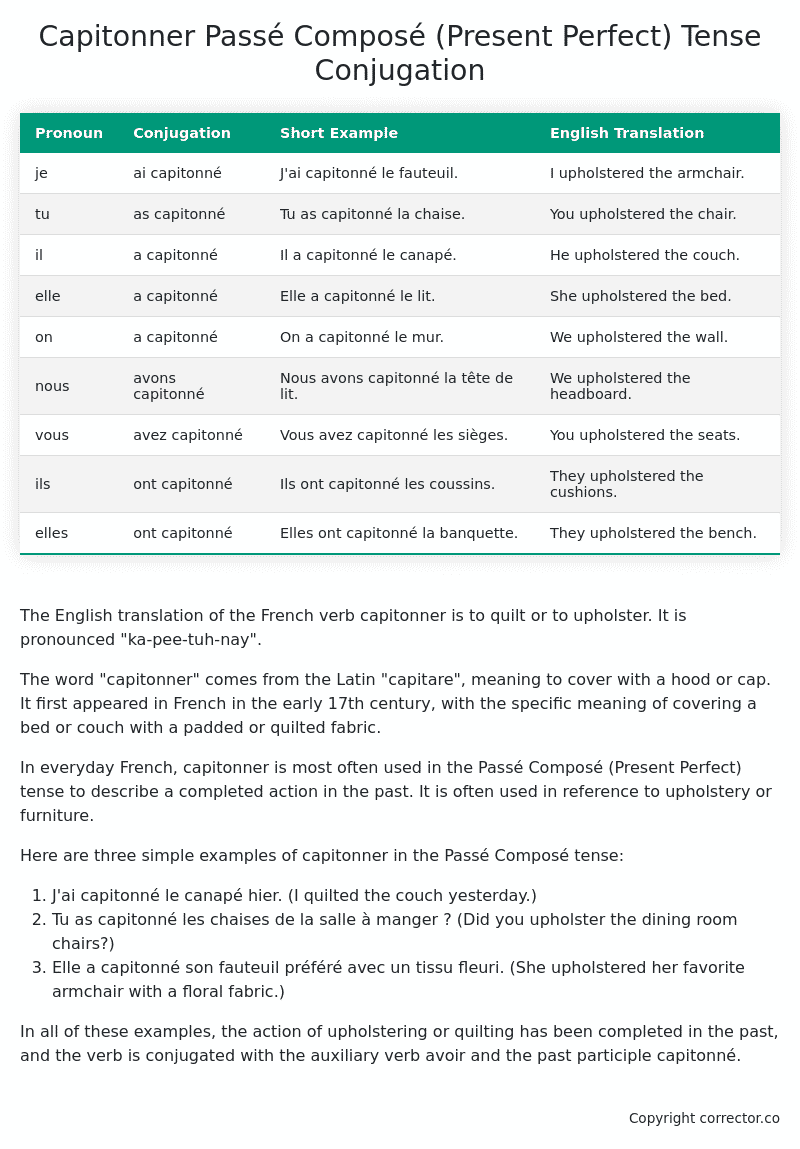Passé Composé (Present Perfect) Tense Conjugation of the French Verb capitonner
Introduction to the verb capitonner
The English translation of the French verb capitonner is to quilt or to upholster. It is pronounced “ka-pee-tuh-nay”.
The word “capitonner” comes from the Latin “capitare”, meaning to cover with a hood or cap. It first appeared in French in the early 17th century, with the specific meaning of covering a bed or couch with a padded or quilted fabric.
In everyday French, capitonner is most often used in the Passé Composé (Present Perfect) tense to describe a completed action in the past. It is often used in reference to upholstery or furniture.
Here are three simple examples of capitonner in the Passé Composé tense:
- J’ai capitonné le canapé hier. (I quilted the couch yesterday.)
- Tu as capitonné les chaises de la salle à manger ? (Did you upholster the dining room chairs?)
- Elle a capitonné son fauteuil préféré avec un tissu fleuri. (She upholstered her favorite armchair with a floral fabric.)
In all of these examples, the action of upholstering or quilting has been completed in the past, and the verb is conjugated with the auxiliary verb avoir and the past participle capitonné.
Table of the Passé Composé (Present Perfect) Tense Conjugation of capitonner
| Pronoun | Conjugation | Short Example | English Translation |
|---|---|---|---|
| je | ai capitonné | J’ai capitonné le fauteuil. | I upholstered the armchair. |
| tu | as capitonné | Tu as capitonné la chaise. | You upholstered the chair. |
| il | a capitonné | Il a capitonné le canapé. | He upholstered the couch. |
| elle | a capitonné | Elle a capitonné le lit. | She upholstered the bed. |
| on | a capitonné | On a capitonné le mur. | We upholstered the wall. |
| nous | avons capitonné | Nous avons capitonné la tête de lit. | We upholstered the headboard. |
| vous | avez capitonné | Vous avez capitonné les sièges. | You upholstered the seats. |
| ils | ont capitonné | Ils ont capitonné les coussins. | They upholstered the cushions. |
| elles | ont capitonné | Elles ont capitonné la banquette. | They upholstered the bench. |
Other Conjugations for Capitonner.
Le Present (Present Tense) Conjugation of the French Verb capitonner
Imparfait (Imperfect) Tense Conjugation of the French Verb capitonner
Passé Simple (Simple Past) Tense Conjugation of the French Verb capitonner
Passé Composé (Present Perfect) Tense Conjugation of the French Verb capitonner (this article)
Futur Simple (Simple Future) Tense Conjugation of the French Verb capitonner
Futur Proche (Near Future) Tense Conjugation of the French Verb capitonner
Plus-que-parfait (Pluperfect) Tense Conjugation of the French Verb capitonner
Passé Antérieur (Past Anterior) Tense Conjugation of the French Verb capitonner
Futur Antérieur (Future Anterior) Tense Conjugation of the French Verb capitonner
Subjonctif Présent (Subjunctive Present) Tense Conjugation of the French Verb capitonner
Subjonctif Passé (Subjunctive Past) Tense Conjugation of the French Verb capitonner
Subjonctif Imparfait (Subjunctive Imperfect) Tense Conjugation of the French Verb capitonner
Subjonctif Plus-que-parfait (Subjunctive Pluperfect) Tense Conjugation of the French Verb capitonner
Conditionnel Présent (Conditional Present) Tense Conjugation of the French Verb capitonner
Conditionnel Passé (Conditional Past) Tense Conjugation of the French Verb capitonner
L’impératif Présent (Imperative Present) Tense Conjugation of the French Verb capitonner
L’infinitif Présent (Infinitive Present) Tense Conjugation of the French Verb capitonner
Struggling with French verbs or the language in general? Why not use our free French Grammar Checker – no registration required!
Get a FREE Download Study Sheet of this Conjugation 🔥
Simply right click the image below, click “save image” and get your free reference for the capitonner present perfect tense conjugation!

Capitonner – About the French Passé Composé (Present Perfect) Tense
Formation of the Passé Composé
Set the auxiliary verb with either
Conjugate the auxiliary verb
Add the past participle
Common everyday usage patterns
Narrating Past Events
Sequential Actions
Describing Completed Actions
Interactions with other tenses
Imperfect Tense
Conditional and Future Tenses
Summary
I hope you enjoyed this article on the verb capitonner. Still in a learning mood? Check out another TOTALLY random French verb conjugation!


